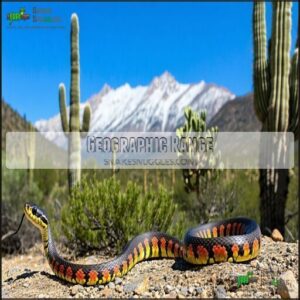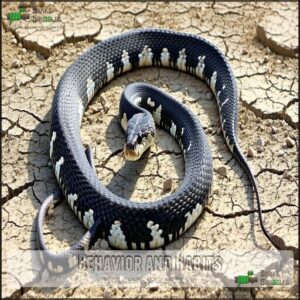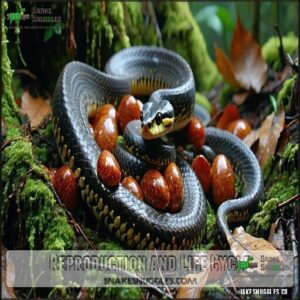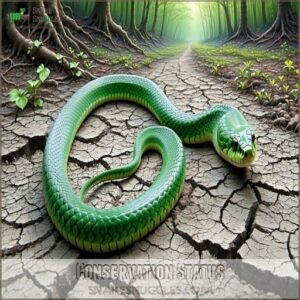This site is supported by our readers. We may earn a commission, at no cost to you, if you purchase through links.
 You’ll love California king snakes!
You’ll love California king snakes!
These stunning reptiles sport black and white bands (though they come in many colors) and grow 3-4 feet long.
They’re natural-born hunters that can even eat other snakes—talk about having your neighbor for dinner!
In the wild, you’ll find them slithering through California’s diverse habitats, from deserts to woodlands.
They’re docile creatures that make fantastic pets for beginners, requiring minimal setup compared to other reptiles.
Their defensive "rattling" tail trick might fool predators, but don’t worry—they’re completely harmless to humans.
Wait until you see how they smoothly constrict their prey!
Table Of Contents
- Key Takeaways
- California King Snake Overview
- Physical Characteristics
- Distribution and Habitat
- Behavior and Habits
- Reproduction and Life Cycle
- Diet and Prey
- Conservation Status
- Keeping King Snakes as Pets
- Frequently Asked Questions (FAQs)
- Are California King Snakes Venomous?
- What are some facts about California king snakes?
- What does a California King Snake look like?
- Are there kingsnakes in California?
- Why are California kingsnakes called king snakes?
- What is a California mountain kingsnake?
- Are California kingsnakes friendly?
- Do California kingsnakes bite?
- Are California kingsnakes harmless?
- Why are California kingsnakes good pets?
- Conclusion
Key Takeaways
- You’ll find California king snakes aren’t venomous—they’re constrictors that can grow 3-4 feet long and display stunning black and white bands (though they come in over 50 color morphs).
- You’ll see these adaptable reptiles thriving across diverse habitats from deserts to woodlands, with remarkable immunity to rattlesnake venom that lets them prey on venomous species.
- You’ll appreciate their docile nature as pets, requiring minimal setup with a 40-gallon tank, proper temperature gradient (85-90°F basking area), and 40-60% humidity.
- You’ll benefit from their natural pest control abilities as they consume rodents, birds, and other snakes, with proper captive care allowing them to live 15-20 years.
California King Snake Overview
Across the sun-drenched landscapes of western North America, the California king snake (Lampropeltis californiae) reigns as one of nature’s most remarkable reptiles.
You’ll find these adaptable creatures thriving everywhere from dusty deserts to lush woodlands and even suburban backyards.
These masterful adaptors flourish from parched desert sands to lush forest canopies—and might even be slithering through your garden right now.
These stunning snakes come in various regional variations, with no two patterns looking exactly alike.
They’re famous for their impressive immunity to rattlesnake venom, allowing them to hunt and consume venomous species without harm—a common misconception is that they’re venomous themselves!
King snake basics include their role as natural pest controllers, keeping rodent populations in check.
With proper care, these beneficial reptiles can live 20+ years in captivity.
They require a temperature gradient of 85-90°F for basking.
Species identification is straightforward once you recognize their distinctive banded or striped patterns, making California king snakes perfect for both wildlife enthusiasts and responsible pet owners.
Physical Characteristics
You’ll be amazed by the California king snake’s glossy, banded appearance with its striking patterns of black and white, yellow, or even rare lavender colors.
These medium-sized reptiles typically grow 2.5 to 3.5 feet long, though some impressive specimens can reach up to 7 feet.
Making them just the right size for your terrarium without taking over your entire living room. Complete concepts
Size and Weight
California king snakes pack impressive measurements into their sleek frames.
Adults typically reach an average length of 2.5-3.5 feet, though some giants stretch to nearly 7 feet! Hatchlings start small (under 2 feet) and display steady growth rates throughout their 15-25 year lifespan.
Weight-wise, expect 900-1,400 grams, with females showing noticeable sexual dimorphism by growing larger than males.
Their maximum size potential makes proper enclosure planning essential for these stunning pet reptiles.
Color Morphs
Looking beyond their impressive size, California king snakes showcase a stunning palette of color morphs that make them alluring pets.
Over 50 unique morphs exist, from classic Black and White Banded varieties to the coveted High White morphs with minimal dark markings.
You’ll find Albino Kings displaying vibrant yellows, rare Lavender Morphs with soft purple hues, and distinctive Striped Patterns that run lengthwise instead of banding.
Many hatchlings display pinkish dark areas that transform to white as they mature. With king snake colors ranging from natural reds to bright yellows, each snake boasts its own unique appearance—like nature’s living artwork.
Patterns and Markings
Beyond the stunning colors, you’ll find California king snakes display remarkable patterns that make each one a living work of art.
Their glossy scales showcase either bold banded variations (think zebra-crossing style) or elegant striped morphs running lengthwise down their bodies.
What makes these reptiles special is their pattern uniqueness – no two snakes have identical markings!
Some rare color aberrations create truly showstopping specimens.
- Banded kings rock alternating black and white rings like natural jewelry
- Striped varieties display parallel lines running head-to-tail
- Desert morphs often show high-contrast patterns against sandy backgrounds
- Aberrant patterns mix traditional markings for one-of-a-kind looks
Distribution and Habitat
You’ll find these amazing reptiles throughout the western United States and northern Mexico, where they’ve made themselves at home in everything from dusty deserts to lush forests.
These adaptable creatures don’t mind roughing it, thriving in diverse habitats from sea level all the way up to 7,000 feet in elevation, proving they’re the ultimate outdoor enthusiasts of the snake world.
Geographic Range
You’ll find the remarkable California king snake distributed throughout the Western United States and northern Mexico.
Their geographic range stretches from Oregon down to Baja California, with impressive elevation limits reaching up to 7,000 feet in the Sierra Nevada mountains.
These adaptable reptiles thrive across desert habitats, forest ecosystems, and various mountain ranges.
What’s fascinating is their status as invasive populations in Gran Canaria, Spain, where they’ve established themselves since 1998.
Regional variations occur throughout their range, with notable habitat diversity supporting different color morphs.
Preferred Environments
Moving beyond their geographic borders, these adaptable reptiles show remarkable elevation adaptations across diverse environments.
You’ll spot California king snakes in:
- Rocky hideaways where they can play hide-and-seek with predators
- Sun-drenched desert habitats that would fry your eggs on the sidewalk
- Lush forest ecosystems with all-you-can-eat buffets of prey
- Chilly mountain ranges up to 7,000 feet (they’ve got natural antifreeze!)
- Suburban backyards where they might check your mail
Their microhabitat selection ranges from marshlands to woodland chaparral, showcasing their impressive versatility.
Behavior and Habits
You’ll discover that California king snakes are mostly active at dawn and dusk.
They have a remarkable talent for rattlesnake mimicry when they feel threatened.
They’re quite the talented hunters too, able to eat prey much larger than their heads and even immune to rattlesnake venom, making these sneaky constrictors the true royalty of the reptile world.
Activity Patterns
From rocky outcrops to suburban neighborhoods, California kingsnakes adapt to various habitats, and their daily routines follow equally fascinating patterns.
These remarkable reptiles are primarily crepuscular hunters, most active during dawn and dusk.
Their daily rhythms shift with seasonal changes and temperature influence:
- Mornings and evenings are prime hunting times in moderate weather
- They’ll switch to nighttime activity during summer heat
- Winter brings hibernation as they snooze underground for months
- Spring awakens their foraging behavior as temperatures rise
Catch them in action, and you’ll witness nature’s perfect predator at work!
Defense Mechanisms
While California king snakes aren’t aggressive, they’ve developed impressive defense tactics when feeling threatened.
- Tail rattling behavior: They rapidly vibrate their tail against surfaces to mimic rattlesnakes
- Hissing communication tactics: They produce loud hisses to intimidate predators
- Coiling defense strategy: They’ll roll into a protective ball with their head hidden
- Musk release defense: They spray foul-smelling musk from scent glands to repel attackers
- Mimicry of rattlesnakes: Their tail vibrating closely resembles a rattlesnake’s warning
You’ll appreciate these clever survival tactics that keep them safe in the wild!
As powerful constrictors, they subdue prey by squeezing.
Feeding Habits
California king snakes are food champions with impressive feeding habits.
They’re masters of constriction, wrapping tightly around prey until it can’t breathe. Their remarkable venom resistance lets them take on rattlesnakes without worry!
In the wild, their diet includes:
Diet In the Wild Captivity
Rodents
Snakes
Other Prey
Juveniles eat more frequently, while adults need feeding just weekly.
You’ll notice their prey preference varies by habitat, with snake prey biomass making up nearly half their nutrition!
Reproduction and Life Cycle
You’ll be amazed at how California king snakes transform from tiny eggs to majestic reptiles during their fascinating life cycle.
When spring arrives, these slithery romantics emerge from brumation ready to find a mate and continue their royal lineage.
Mating Season
Spring stirs reproductive habits in California kingsnakes as warmer temperatures trigger their courtship rituals. After displaying fascinating behavior patterns, these reptiles now turn their attention to finding mates.
When these snakes reach 3-4 years old, they’re ready for their annual breeding cycles from March through June. You’ll notice males searching intensely for receptive females during this time.
- Males track females through scent trails left on the ground
- Competing males engage in "combat dancing" where they intertwine and wrestle
- Successful males court females with gentle chin rubbing and body alignment
- After mating, females begin internal egg formation within 24-48 hours
Egg Laying and Incubation
Following the motherly instinct, female kingsnakes lay their clutch of 5-12 leathery eggs beneath logs after breeding cycles complete.
You’ll find egg formation happens about four weeks after mating.
| Incubation Aspect | Details |
|---|---|
| Clutch Size | 5-12 eggs |
| Temperature | 27-28°C (80-82°F) |
| Humidity Levels | Moderate to high |
| Incubation Period | 60-70 days |
| Egg Care | No turning needed |
Nature’s delicate incubator requires patience!
Hatchling Development
Freshly hatched king snake babies commence on a remarkable growth journey, doubling in size during their first year.
These tiny explorers display their unique personalities after their First Shed, typically 7-10 days post-hatching. Ball python hatchlings, for example, require a specific temperature and humidity to thrive.
- Their Growth Rate accelerates after their Initial Feeding, transforming 8-inch hatchlings into foot-long juveniles within months
- During the Vulnerability Period, they’re nature’s most delicate incubators of potential
- Dramatic Color Changes occur as they mature, with patterns brightening or softening
Watch as your hatchling develops its distinctive character!
Diet and Prey
You’ll be amazed at how California king snakes are the ultimate reptile foodies, happily dining on everything from mice and birds to other snakes (even venomous rattlesnakes they’re immune to).
Their impressive hunting skills and varied diet make them fascinating to watch at mealtime.
Whether they’re constricting prey in the wild or gobbling up pre-killed mice in your home terrarium.
Rodents and Birds
Regarding mealtime, king snakes don’t mess around.
These clever hunters show a strong preference for rodents and birds in their diet. You’ll see them ambushing prey and using powerful constriction to subdue it.
They’re particularly fond of rodents measuring 20-33 cm, making them excellent natural pest controllers. Their hunting strategies also include targeting ground-nesting birds and their eggs.
Many owners utilize pre-killed prey options for feeding.
Other Snakes
While rodents make up a good portion of their diet, California king snakes truly earn their royal title by eating other snakes.
They’re ophiophagous (snake-eaters) with a remarkable immunity to rattlesnake venom.
When hunting other serpents, these kings display:
- Incredible strength – they’re the strongest constrictors for their size
- Fearless hunting of venomous look-alikes
- Amazing immunity to snake venom
- Strategic hunting techniques unlike other Snake Diversity
This snake-eat-snake behavior showcases their dominant position in Snake Evolution.
They also play a crucial ecological role in controlling prey populations.
Captive Feeding
While king snakes hunt other serpents in the wild, captive feeding is much simpler.
Your California king snake will happily accept frozen-thawed mice as their primary diet.
For perfect kingsnake nutrition:
- Feed adults once every 10-14 days, younger snakes every 7-10 days
- Choose prey size that’s 10-15% of your snake’s weight
- Always feed inside the enclosure, not in separate containers
- Thaw frozen food completely and warm to room temperature
- Watch for normal snake behavior after meals—hiding indicates proper digestion
For king snake owners, frozen reptile food is a convenient option.
Skip live prey—it’s safer for both you and your pet!
Conservation Status
You’ll be happy to know that California king snakes aren’t currently listed as endangered or threatened, so you can admire these beautiful reptiles without worry.
Their adaptability to various habitats, from deserts to suburban areas, has helped them maintain stable populations despite some challenges from habitat loss and road accidents.
Population Trends
Despite limited data, California King Snake populations likely exceed 10,000 individuals across their range.
You’ll find them thriving throughout California, Arizona, New Mexico, and southern Utah, with an isolated population in Washington about 200 miles from their main distribution.
Their secretive nature and remote habitats make population monitoring challenging, though they’re considered locally common.
Climate impact and urbanization effects haven’t greatly threatened their numbers yet, keeping their conservation status at "least concern."
As colubrid snakes, they possess fangs located on the back portion of their jaw.
While specific population trends remain unclear, their impressive adaptability to varied environments and stable reproductive patterns suggest these stunning reptiles will continue to maintain healthy numbers.
Threats and Protections
While California kingsnakes maintain stable populations, they face mounting challenges.
Habitat loss and fragmentation pose serious threats, as urbanization destroys their natural environments.
These remarkable reptiles also contend with:
- Road mortality, where countless snakes meet unfortunate ends on highways
- Illegal pet trade, particularly affecting rarer morphs
- Competition from invasive species in their native range
Conservation efforts focus on protecting these natural "pest controllers" through habitat preservation and public education.
Keeping King Snakes as Pets
You’ll find California king snakes make excellent pets for both beginners and experienced reptile enthusiasts due to their docile nature and simple care requirements.
With proper housing, regular feeding, and gentle handling, these striking reptiles can become your fascinating companions for up to 20 years.
Turning heads whenever friends visit your home snake sanctuary.
Housing Requirements
Your royal reptile deserves a proper castle!
For your kingsnake enclosure, start with a secure 40-gallon tank with escape-proof openings.
Use aspen shavings as substrate options that won’t cause tummy troubles.
Maintain a temperature gradient with a warm side (88-92°F) and cool side (75-80°F) for proper thermoregulation.
Keep humidity levels at 40-60% , measured with a digital hygrometer. A key element is to guarantee optimal humidity levels to facilitate healthy shedding.
Add hiding spots on both temperature zones and climbing branches for enrichment ideas that’ll make your slithery friend feel right at home!
Handling and Care
Now that you’ve set up the perfect king snake enclosure, it’s time to handle your scaly friend correctly!
Safe handling of your king snake pet involves:
- Moving slowly and confidently – sudden movements make them jumpy as a cat on a hot tin roof!
- Supporting their body fully – nobody likes dangling mid-air!
- Limiting sessions to 10-15 minutes – even reptiles need their alone time!
Wash hands before and after handling to prevent spreading germs.
Consider using specialized reptile tools for added safety.
During shedding periods, maintain the proper temperature gradient and give them space – they’re extra sensitive then!
Frequently Asked Questions (FAQs)
Are California King Snakes Venomous?
You’ve got nothing to worry about! California King Snakes aren’t venomous at all. They’re constrictors that squeeze their prey instead, making them safe to handle with proper care and respect.
What are some facts about California king snakes?
Did you know these slithery royals rule the reptile world?
You’ll find king snakes reaching up to 7 feet long, sporting glossy black and white bands.
They’re non-venomous but can tackle rattlesnakes with immunity to their venom.
What does a California King Snake look like?
You’ll recognize California King Snakes by their glossy scales with bold black and white bands or stripes. They’re medium-sized, typically 5-5 feet long, with some reaching 7 feet in rare cases.
Are there kingsnakes in California?
Yes, you’ll find California kingsnakes throughout the state!
They’re native residents, living in diverse habitats from coastal areas to mountains, deserts to forests.
You can spot them from Oregon to Mexico too. They’re native residents, living in diverse habitats from coastal areas to mountains, deserts to forests.
Why are California kingsnakes called king snakes?
California kingsnakes earned their royal title because they’re famous for eating other snakes, including venomous ones like rattlesnakes.
They’re immune to rattlesnake venom, making them the true "kings" of their habitat.
What is a California mountain kingsnake?
The California Mountain Kingsnake differs from its royal cousin with its vibrant red, black, and white bands.
You’ll spot these non-venomous beauties slithering through high-elevation forests and rocky slopes across California’s mountains.
Are California kingsnakes friendly?
Most California kingsnakes are friendly and become docile with regular handling.
They’ll occasionally display defensive behaviors like tail rattling when startled, but you’ll find they’re generally calm pets once they adjust to you.
Do California kingsnakes bite?
While typically docile, California kingsnakes may bite when stressed or handled improperly.
You’ll rarely face their tiny teeth, but if you’re gentle and confident, they’ll likely become your scaly, non-venomous friend instead. Complete concepts
Are California kingsnakes harmless?
While they’ll occasionally nip when stressed, California kingsnakes are completely non-venomous and harmless to humans.
You’ll find they’re actually beneficial since they help control rodent populations and even eat venomous rattlesnakes!
Why are California kingsnakes good pets?
You’ll love California kingsnakes as pets!
They’re docile, easy to handle, and don’t need much space.
Their beautiful patterns, reasonable size, and simple care requirements make them perfect for both beginners and experienced snake owners.
Conclusion
Meet Tony, whose California king snake "Checkers" fascinated neighborhood kids with handling demonstrations.
Whether you’re a first-time owner or experienced enthusiast, these remarkable reptiles offer years of low-maintenance companionship.
With proper care, your banded buddy will thrive for 15-20 years!
Browse our California king snakes facts with pictures and video to learn more about these fascinating creatures before bringing one home.
They’re not just pets—they’re conversation starters with scales!

















